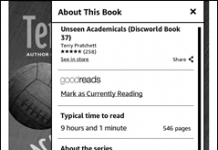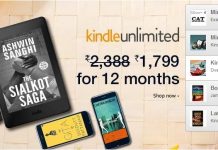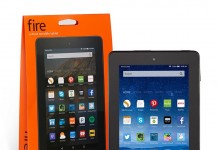 They didn’t create the first ebook device. Sony’s original Reader had more than a one year head-start on the Kindle. What they were first with though was a platform that made wireless ebook buying a snap; Whispernet was a game-changer.
They didn’t create the first ebook device. Sony’s original Reader had more than a one year head-start on the Kindle. What they were first with though was a platform that made wireless ebook buying a snap; Whispernet was a game-changer.
Next, they had the vision to create a Kindle reader app for every platform known to man. Want to read a Kindle book on your Windows laptop? No problem. On a Mac? Absolutely. On an Android device, an iPhone, iPad or Blackberry? Check, check, check, and check. This, btw, is what made me comfortable building up a library of Kindle content. I pity the sucker who’s bought a ton of content from Apple’s iBookstore; that person is locked in with Apple for the rest of their lives.
Of course, the more ebooks I buy from Amazon the more I’m locked in with them down the road. But I don’t mind. That’s a key part of Amazon’s secret sauce. Btw, when I say “locked in”, I’m talking about the content platform, not the hardware platform. I plan to buy a Kindle tablet on day one, but if another Android tablet comes along a year or so later and is better, I’ll probably switch to it.
I’ve been asked why I don’t buy econtent from Barnes & Noble or Kobo. After all, they too offer apps on a variety of platforms. I’d rather stick with one reader app I’m used to and not have to remember which options are/aren’t available (or how they work) in other apps. Then there’s the practical side. if I want to search for a phrase I know I read but I can’t remember which ebook it was in, it’s easy to search across your entire collection…as long as that collection was purchased from the same ebookstore! Good luck searching simultaneously across your Kindle ebooks, your Nook ebooks, and your Kobo ebooks. It can’t be done. In fact, cross-library features like this are something I’ll bet each vendor will build up further, again, with an eye on keeping you loyal to them.
So the fact that I keep buying more and more econtent from Amazon, just like many of you, means I’m making it harder and harder to ever abandon them. But as long as they keep supporting all platforms I’m perfectly content to keep doing this.
P.S. — It’s no secret that I’m a huge Amazon fan. In fact, I took the Amazon position in a fun Tools of Change (TOC) for Publishers webcast debate we recently had. In that debate I presented the five key reasons why I feel Amazon’s platform is superior to Apple’s. You can watch it via this link or the embedded version below.
































Agreed. While as a writer I don’t like Amazon (or anyone else’s) domination of retail book and ebook sales, but I do think that Amazon has earned its Number 1 spot in the ebook market through hard work and investment.
I’d hoped Apple would give them some healthy competition, but I’ve been sadly disappointed. Heck, I can’t even display ebooks from the iBookstore on my Macs. Amazon lets me direct any ebook I get from them–and the Seattle Public Library–books to any of my devices. No klutzing with USB cables either.
What you said about Whispernet is true. Amazon seems to be first to realize that digital books isn’t just about a reader. It’s an entire ecosystem.
No, no, no, the Nook devices have much better tech specs, and Nook at least embraced epub standard wholeheartedly (while Amazon is sticking with a moribund format which guarantees ugly ebooks).
What amazon.com has is an infinitely better website and better author tools for indies. Frankly I am astonished at how pitiful BN’s website is in comparison.
What Amazon also has over B&N is amazing customer service.
You know, all this contant focus on “the epub standard” by Amazon opponents is aoso part of Amazon’s success. 🙂
Out in the real world, people don’t shop for epub readers, they shop for ebook readers.
People don’t look at the specs of the format or whether it supports multi-level TOCs or embedded fonts, or any of the “must-have” features of the oh-so-superior “standard”; they look at the price, the availability of books, the ease of use.
Look at Amazon’s TV ads. They’re short. They’re snappy. They’re simple. What do they talk about? Whispersync? Library access? Format? Nope. The talk about getting ebooks anywhere. About reading outdoors. About low price.
Amazon’s secret? They sell ebook access. It’s that simple.
They don’t obsess over the gadget features; Kindles are actually on the simplistic side, features-wise. But what they do, they do well. And the features they do seem to matter to more people than the ones they don’t.
They don’t make a fuss over formats; they’ll sell mobi, topaz, even pdf (which is apparently what the new print replica format is), and if epub3 ever reaches the market, they might just wrap it in their drm, change the extension to azw3, and sell those too. Amazon doesn’t sell mobi ebooks, they sell kindle ebooks and Kindle ebooks are whatever Amazon says they are. And that is fine with consumers, because they just want to read.
The problem I see here is that ebooks and readers are now a mainstream consumer product aimed at recreational readers. Readers are no longer tech toys aimed at hobbyists and enthusiasts and they are not not useful academic tools. Specs and formats don’t matter enough to determine sales. Some of Amazon’s competitors (B&N, KOBO) caught on quick to this fact, others have yet to get it.
Success in ebooks *today* does not lie in appealing to techies, academics, or the spec/format obsessed. It lies in everyday consumers looking for recreational fiction and the odd non-fiction history or current affairs text. This is the low-hanging fruit that will set the tone for the further evolution of the industry, not specs or format standards. Not yet.
Sucessful retailers deal with the customers they have or they can reach, not the customers they wish they had. And today’s buyers just want fast, easy access to ebooks as cheaply as possible.
“Amazon is sticking with a moribund format which guarantees ugly ebooks”
I’m not so sure I’d call Amazon ebooks ugly. If fact, the epub format looked much worse on my Kobo. The one ebook I purchased had improper paragraph formatting for books: it was more like the formatting you’d find on web page comments: blank space between paragraphs and no indent. I emailed a complaint to Kobo customer service and their reply was basically, “Sorry, Charlie, formatting comes from the publisher.” I eventually got the same ebook from Lendle and the formatting was perfect.
The epub format from the library had extra wide margins on both sides of the text, giving the Kobo screen the effective size of an iPhone. I tried it with three different library books and all the margins were off. My Kindle format from the library had perfect margins.
So way call Amazon’s ebooks ugly when epub gets it wrong?
Did you see this presentation about Amazon.com: http://www.slideshare.net/faberNovel/amazoncom-the-hidden-empire
You may be interested by some of the arguments.